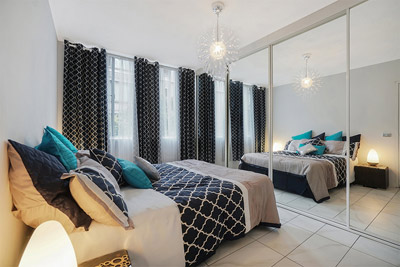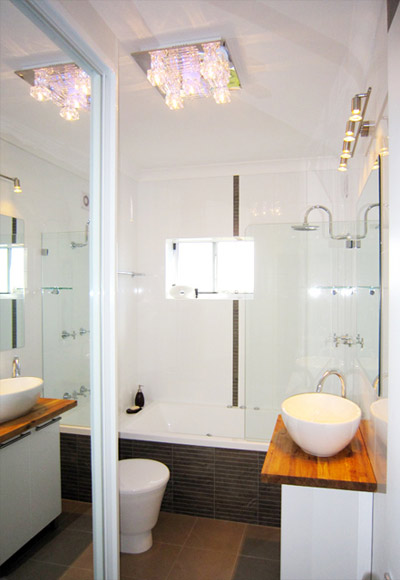Best Surprising Wardrobe Ideas
Girls Love Diamonds – and Wardrobes

Mirrored Wardrobe Visually Doubles the Size of This Bedroom
I have never seen a woman, young or old, who would not be excited by the prospect of living in a house with a great walk-in-robe or closet room. Have you?
In expensive cities, where space is at premium, we often don’t have the luxury of having a spacious wardrobe room. We must live with wardrobes that can barely fit our clothes, shoes and accessories.
While recently redesigning minimal spaces, we have come up with a few ideas for wardrobes – and we would like to share them with you.
Think Outside the Bedroom – and Inside, Too

Bathroom: On the left, there is a laundry cabinet hidden inside a closet with mirror door.
If you have small bedrooms, you may consider having wardrobes in other rooms too. A hallway, nooky space in the attic, a spacious living room or a family room – they may all be great places to install wardrobes. Naturally, most people will have wardrobes in their bedrooms, too.
Wardrobe That LOOKS GOOD
Gone are the days of a wardrobe that has been in the same room for decades. Wardrobe cabinets tend to age, an old and dated wardrobe will, in most cases, detract from the appearance of your room. Time to update it. Replace or renovate your wardrobe. I usually to renovate antique wardrobes, and newer ones only if they are made of solid timber. This is a beautiful Edwardian wardrobe that once lived in my house. Miss you, my grand dame! I know your new owners love you as much as I did.
Wardrobes made of timber conglomerates, in most cases, are not worth updating. For the below reason.
Thy Wardrobe Must Not Stink
You want your precious, beautiful clothes to smell fresh and clean. Old wardrobes made of particleboards and other manmade materials, tend to aggregate humidity and develop unpleasant lasting smell. In my view, there is only one solution to the problem: out with the old, and in with the new. Your one designer frock may cost you more than the whole new wardrobe.
Wardrobe Ventilation
Wardrobes tend not to have a good air circulation. The result? Mould in wardrobes, stinky clothes. Consider drilling ventilation holes at the top, back or side of your wardrobe. Also, make sure your wardrobe room has plenty of flow of natural fresh air. In humid climates, you may want to put a dehumidifier near your wardrobes. Or, at least, use an air fan near your wardrobe, with the wardrobe door open. Not to mention that your clothes require proper exposure to fresh air outside every now and then.
Invisible Wardrobe
Now you see me, now you don’t. When you don’t see me, you see the room twice as big as it is. Why? Because the wardrobe has mirror doors. Put a few such wardrobes together, as tall as your space allows – and you have created a great storage space that is invisible at first sight. This is my absolutely favourite trick for small spaces. Not only have you gained massive extra storage, but also your room looks significantly bigger, more lively and full of light.
Concealed Wardrobe Wall
Imagine a wall that has timber panelling. You touch one panel – and, pop, opens the door of one of your wardrobes. With touch open and close systems wardrobes don’t have to have handles. You can create a floor-to-ceiling wardrobe that will pretend to be just a timber wall. You will be able to store massive amounts of stuff in this gigantic wardrobe.
Slide It OUT!
Most wardrobes have sliding doors, do they? Now, I dislike any sliding door with passion. Sliding doors tend to slope, drop in their rails, get stuck, with time they become clunky and noisy.
Hinged doors, on the other hand, are lasting, reliable and quiet as a mouse for years.
Also, if you have hinged doors, you can hang a coat hanger on the door handle.
Need more reason for hinged doors? You can have a mirror on the inside of the hinged door. No use installing a mirror on the inside of sliding door though.
Conclusion: OUT with sliding doors in wardrobes, and IN with hinged doors.
Time to Lose Depth
Standard wardrobe depth is around 60 cm. I find this depth good for hanging clothes and storing bulky items.
But what do you do with shelves that are 60cm deep? How do you store nicely folded clothes on them? In two rows one in front, and the other at the back of the shelf? What happens if you need to quickly find something from the back row?
From my experience, deep shelves lend themselves to almost never-ending mess. They are just too deep to be practical. Especially if your house is inhabited by young people who, thank God, don’t want to waste their life folding t-shirts into perfect squares.
The same applies to linen cabinets. Deep shelves encourage mess.
In the recent years, I have been using much narrower wardrobes, only approximately 40 cm deep. They are excellent, clothes on my shelves stay in neat order for months. Nowadays, I often add a whole row of 40 cm deep wardrobes with mirrored, hinged doors to a room. The user gets the benefit of a large amount of very functional and easy to maintain storage space, and the room gets the benefit of looking twice its actual size, being full of life and light. Problems solved.
Next page: Tricks How to Update and Old Bathroom
Happy decorating
Xena

